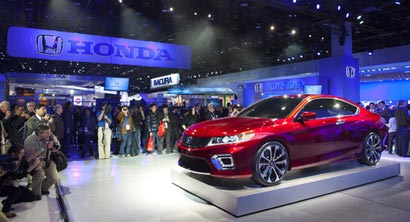automotive
Toyota, Honda Put 2011 Behind Them
- by Karl Greenberg , January 10, 2012

Toyota and Honda had a rough year in 2011 thanks to a pair of natural and man-made disasters. The two companies saw sales drop and share recede even as others were building share back and sales volume.
But the two automakers came to the North American International Auto Show (NAIAS) in Detroit with a messag -- not made explicit that -- to (probably) misquote my sainted grandmother's favorite Russian proverb, "The morning is more clever than the night." Both automakers want, no doubt, to forget last year and focus on what's next.
John Mendel, EVP of American Honda Motor, speaking at Honda's NAIAS press conference, did mention 2011 -- but the look back was mostly about milestones. At the event, where Honda unveiled the ninth-generation Accord, Mendel said the car will go on sale at around the time the company is celebrating its 30th anniversary of automobile production in the U.S. "We have sold more than 11 million Accords in America," he said. "And more than 8 million of them have been built in America as well."
advertisement
advertisement
But he conceded that 2011 was tough, although not a sales trend. "To say that the past year has been one of incredible challenge is a gross understatement. 2011 was a year that saw our company weather two devastating natural disasters that severely disrupted our global supply chain. The reality is we had to cut more than 200,000 units from our production schedule. And we still topped one million units in sales for the year."
Mendel went on to say that if competitors gained on Honda last year, it was because Honda was wearing a cast. "But we have returned to full production with a strengthening product lineup. We're here to serve notice to the competition that Honda is firing on all cylinders again."
Mendel said Honda's first plug-In hybrid vehicle will be a 2013 Accord. The car, he said, will go 15 miles on electric power alone, with the driver able to control when the vehicle operates in all-electric mode, and will fully recharge in less than one and a half hours using a 240-volt charger.
Honda's upscale sibling Acura yesterday made a big design statement with the ILX compact sedan concept that returns to an understated, although sleeker look, and reins in the grill design, which has gotten somewhat exuberant over the past couple of years.
"The styling really repaired their image," says Jim Sanfilippo, COO of Hyundai Motor America's AOR Innocean USA (who has a long automotive CV on the client side of the fence). "All of these near-luxury brands -- Infiniti, Acura, Lexus -- have upped their with design game. But the Acura guys have their discipline down now; they seem to know what they want to look like."
He tells Marketing Daily that he was blown away by Ford's Fusion. "It's a game changer for them. The question is whose hide will [sales of the new Fusion] come out of?" He also has kudos for Honda's Accord coupe, and has little doubt that Ford will bring Lincoln back. "Look at what that company has done in three years."
Over at Toyota's booth Jim Lentz, president and COO of the Torrance, Calif.-based Toyota Motor Sales, U.S.A., Inc., talked up the latest and third Prius variant (four if you count the Prius plug-in hybrid), the Prius c -- the smallest hybrid in the lineup. He said Toyota's approach is to offer a portfolio of different alternative-power technologies, from hybrid and plug-in hybrid to electric, natural gas, and ultimately fuel-cell. But he also conceded that ultimately the kinds of vehicles that populate roads reflect a push-pull between consumers and automakers.
"Toyota believes that a wide variety of technology options must be developed. This portfolio approach is driven by the notion that hydrogen fuel cells might be the right answer in one region of the world while battery-electrics or natural gas might be best in another. However, the necessary first step is to get consumers to literally buy into the plan in sustainable volume," he said.
Lentz touted the fact that the 11-year-old Prius nameplate now sells in volume and has a multi-model lineup. "When [Prius] arrived in America in July 2000, many of us at Toyota called it the biggest crap-shoot we’d ever attempted. We were elated to sell nearly 6,000 units in the last six months of that launch year ... today about one out of every two total hybrid cars and trucks sold in this country is a Prius."
The Prius c, designed as an urban-market vehicle, and a car Toyota is calling a "gateway vehicle" for the bigger, more expensive Prius vehicles, is a five-door hatchback that will go on sale this March.
Meanwhile, Toyota's Scion brand has replaced the matchbox-car-style stacked displays it has used heretofore, expanded its space, and installed a product and media theater called “Thunderdome,” via Michigan-based George P. Johnson.
The company says the 15-foot-tall, overhead LED structure encloses nine display vehicles with the spotlight on the 2013 Scion FR-S compact rear-wheel drive sports car the division unveiled in Detroit.
“Philosophically, we needed a modular canvas to showcase the breadth of our growing product line,” said Steve Hatanaka, auto shows and special events manager at Scion, in a statement.




